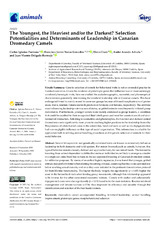Mostrar el registro sencillo del ítem
The Youngest, the Heaviest and/or the Darkest? Selection Potentialities and Determinants of Leadership in Canarian Dromedary Camels
| dc.contributor.author | Iglesias Pastrana, Carlos | |
| dc.contributor.author | Navas González, Francisco Javier | |
| dc.contributor.author | Ciani, Elena | |
| dc.contributor.author | Arando Arbulu, Ander | |
| dc.contributor.author | Delgado-Bermejo, J.V. | |
| dc.date.accessioned | 2021-10-05T10:31:49Z | |
| dc.date.available | 2021-10-05T10:31:49Z | |
| dc.date.issued | 2021 | |
| dc.identifier.uri | http://hdl.handle.net/10396/21847 | |
| dc.description.abstract | Several idiosyncratic and genetically correlated traits are known to extensively influence leadership in both domestic and wild species. For minor livestock such as camels, however, this type of behavior remains loosely defined and approached only for sex-mixed herds. The interest in knowing those animal-dependent variables that make an individual more likely to emerge as a leader in a single-sex camel herd has its basis in the sex-separated breeding of Canarian dromedary camels for utilitarian purposes. By means of an ordinal logistic regression, it was found that younger, gelded animals may perform better when eliciting the joining of mates, assuming that they were castrated just before reaching sexual maturity and once they were initiated in the pertinent domestication protocol for their lifetime functionality. The higher the body weight, the significantly (p < 0.05) higher the score in the hierarchical rank when leading group movements, although this relationship appeared to be inverse for the other considered zoometric indexes. Camels with darker and substantially depigmented coats were also significantly (p < 0.05) found to be the main initiators. Routine intraherd management and leisure tourism will be thus improved in efficiency and security through the identification and selection of the best leader camels. | es_ES |
| dc.format.mimetype | application/pdf | es_ES |
| dc.language.iso | eng | es_ES |
| dc.publisher | MDPI | es_ES |
| dc.rights | https://creativecommons.org/licenses/by/4.0/ | es_ES |
| dc.source | Animals 11(10), 2886 (2021) | es_ES |
| dc.subject | Dromedary camel | es_ES |
| dc.subject | Sex-separated breeding | es_ES |
| dc.subject | Intraherd leadership | es_ES |
| dc.subject | Animal handling improvement | es_ES |
| dc.subject | Pleiotropic genes | es_ES |
| dc.subject | Morphofunctional selection | es_ES |
| dc.title | The Youngest, the Heaviest and/or the Darkest? Selection Potentialities and Determinants of Leadership in Canarian Dromedary Camels | es_ES |
| dc.type | info:eu-repo/semantics/article | es_ES |
| dc.relation.publisherversion | https://doi.org/10.3390/ani11102886 | es_ES |
| dc.relation.projectID | Gobierno de España. APCIN-2016-00011-00-00 | es_ES |
| dc.rights.accessRights | info:eu-repo/semantics/openAccess | es_ES |

